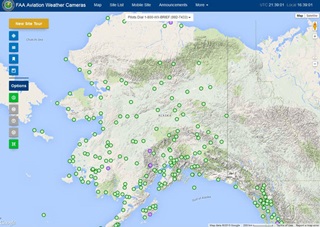
The decision to launch is more complicated in Alaska, where nearly 300 communities have no connection to a road network and rely on aircraft as a lifeline, not a luxury. Pilots must often rely on a mixture of information and experience, since automated weather stations are few and far-flung compared to other states.
The FAA took over what was then a tiny weather camera program in 1999, assuming responsibility for a network of three cameras installed by a University of Alaska Fairbanks grad student to test the efficacy of such cameras. By 2011, the FAA had installed 150 weather cameras at key locations around the state—primarily airports, along with a few mountain passes and other remote locations.
The cameras have proved immensely popular among Alaska aviators, and the network has been expanded in large part due to a well-accepted understanding of the critical importance of providing pilots with as much weather information as possible. The FAA announced recently that the network has expanded to its final complement of 221 locations, noting the program was finished ahead of time and on budget. Pilots can access images, and in some cases automated weather reporting, from all of those locations through the agency website.

AOPA Alaska Regional Manager Tom George has worked alongside fellow aviators and aviation groups for years in support of the weather camera program, which is currently limited primarily to daylight hours. While it provides almost around-the-clock coverage during long summer days, during the winter months pilots must still make go/no-go decisions before enough light is available to obtain a camera image. George is collaborating with others in Alaska’s general aviation community to push for support and funding to test technologies such as infrared cameras, or cameras able to capture images with low visible light, and learn how they might expand the system to closer to 24-hour-a-day operations. George said such tests must include examination of human factors, and how pilots will interpret such imagery.
“There are many facets to weather that we are digging into in the state, and some are pretty strong advocacy issues that AOPA is working on,” George said.
Meanwhile, like other Alaska pilots, George is a fan of the cameras.
“I use this system all the time,” George said. “It makes a huge difference in figuring out whether you can fly or not fly at a given time.”
As the FAA noted, it also saves fuel and other resources when pilots can figure out before they launch that a given destination will have to wait for clearer conditions.



